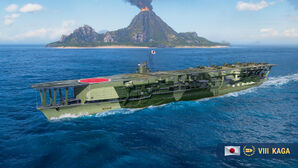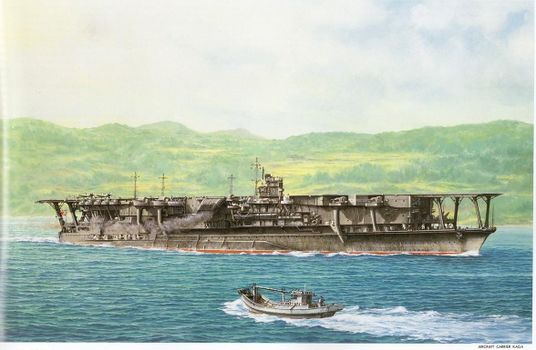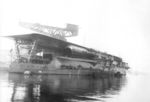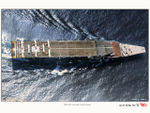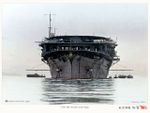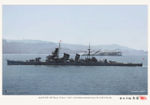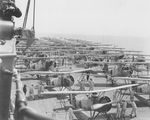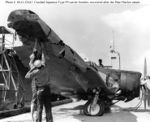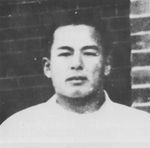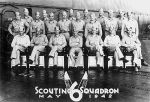Kaga
| Revision as of 04:00, 5 June 2017 | Revision as of 21:51, 27 January 2021 WG recommended skills v3 | |||
36 intermediate revisions by 18 users not shown | ||||
| Line 4: | Line 4: | |||
| |Anno=<!-- you can write below short description for the ship. it will replace default once. --> | |Anno=<!-- you can write below short description for the ship. it will replace default once. --> | |||
| + | Until the early 1940s, she was one of the biggest aircraft carriers of the Imperial Japanese Navy. Initially laid down as a battleship, she was redesigned during construction to become a carrier. The ship had good armor protection for her type, carried quite numerous air group and powerful secondary battery guns.<br><br> ''Kaga'' first went on sale on 2 June 2017 on the EU servers, and on 5 June 2017 on the NA servers. <br><br>{{Model3DViewer|36ed2275650341fe8a72d07a5037bfa8}} | |||
| |Performance=<!-- write text about performance in battles below --> | |Performance=<!-- write text about performance in battles below --> | |||
| + | ''Kaga'' is a Tier VIII premium Japanese aircraft carrier. Unlike ''[[Saipan]]''’s style of having fewer, higher tier aircraft, ''Kaga'' instead provided her captain with large numbers of lower tier aircraft. She is able to launch copious amounts of bombers at the enemy team, but must be careful of the anti-aircraft abilities of same and higher-tier ships. With proper target selection and flak avoidance, ''{{#var:ship_name}}'' can strike even Tier X targets and still have full squadrons ready to go in the latter stages of the game. | |||
| ? | + | Unlike the IJN tech tree carriers, ''{{#var:ship_name}}'' has HE dive bombers. She drops four bombs per drop with 3 drops per squadron. What makes these dive bombers special is not the bombs, but the attack pattern. The dive bombers dive low very quickly and travel laterally at a very low height at fast speeds, which allows players to drop on targets at a very low height and ensure a high percentage of bomb hits. This is very useful for dropping maneuverable targets such as destroyers and light cruisers. The low height of the drop allows several bomb hits on destroyers per attack, dealing high amounts of damage in proportion to their maximum health. | ||
| ? | '' | + | ''{{#var:ship_name}}'''s torpedo bombers are also powerful, but take practice to use. The torpedo bombers drop four torpedoes per drop with 3 drops per squadron. Stealth is one of the biggest strengths of the torpedo bombers, with a base detect of 7.5km. ''{{#var:ship_name}}'' can use this stealth to get a perfect drop angle on targets without the target knowing that they are being targeted. Aim time is another strength of the torpedo bombers, with the lowest aiming time of all Tier VIII carriers. However, the biggest drawback of the torpedoes is long arm time. Due to this, dropping on more agile targets is not advised. Thus, the torpedo bombers are best suited for landing hard hits on slower targets like battleships. | |
| ? | {{ | + | Her rocket aircraft should only be used as a last resort. The rockets are stock ''Shokaku'' rockets, except with less health. Dive bombers do a better job on smaller targets, and torpedo bombers do a better job on larger targets. | |
| ? | + | |||
| + | {{AnnoWiki|content= | |||
| + | '''[https://forum.worldofwarships.com/index.php?/topic/127385-premium-ship-review-kaga LittleWhiteMouse's Premium Ship Review: Kaga] from the NA forums'''}} | |||
| |Pros=<!-- write list of positive points below. use * as in ordinary wiki-list. --> | |Pros=<!-- write list of positive points below. use * as in ordinary wiki-list. --> | |||
| ? | * | + | * Ridiculous amount of planes immediately available on deck | |
| ? | * | + | * Torpedo bombers can reach as low as 6.1km detectability with the right upgrades | |
| ? | * | + | * Torpedo bombers drop four (4) torpedoes per attack run | |
| ? | * | + | * Dive bombers are accurate and use HE bombs, unlike techtree Japanese carriers | |
| ? | + | * Heavy secondary armament for self-defense | ||
| + | * Very good ship concealment with all the relevant upgrades | |||
| + | ||||
| |Cons=<!-- write list of negative points below. use * as in ordinary wiki-list. --> | |Cons=<!-- write list of negative points below. use * as in ordinary wiki-list. --> | |||
| ? | * | + | * Poor ship mobility - not the best speed, huge turn radius and slow rudder shift | |
| ? | * | + | * Planes have a low healthpool and are not very fast | |
| ? | * | + | * Ineffective rockets with low penetration and damage | |
| ? | * | + | * Aerial torpedoes have an extremely long arming distance | |
| ? | * | + | * Torpedo bombers and dive bombers fly in large squadrons, vulnerable to enemy flak bursts | |
| + | * Plane restoration is very slow for a Japanese aircraft carrier | |||
| + | * ''Kaga'''s hull is poorly armored and can take heavy damage from pretty much anything | |||
| + | * Hull secondary armaments have very poor range | |||
| + | ||||
| |Research=<!-- write text about priority sequence of research below --> | |Research=<!-- write text about priority sequence of research below --> | |||
| ? | As a | + | As a Premium ship, ''Kaga'' doesn't have any upgrades to research. | |
| |OptimalConfiguration=<!-- write some general text about selection of optimal configuration below (optional)--> | |OptimalConfiguration=<!-- write some general text about selection of optimal configuration below (optional)--> | |||
| |Upgrades=<!-- write text about best upgrades below --> | |Upgrades=<!-- write text about best upgrades below --> | |||
| ? | + | The recommended upgrades for ''{{#var:ship_name}}'' are as follows: | ||
| ? | + | *'''Slot 1''': {{Air Groups Modification 1}} | ||
| ? | + | *'''Slot 2''': {{Aircraft Engines Modification 1}} | ||
| ? | + | *'''Slot 3''': {{Aerial Torpedoes Modification 1}} | ||
| ? | * | + | *'''Slot 4''': {{Torpedo Bombers Modification 2}} | |
| ? | + | *'''Slot 5''': {{Concealment System Modification 1}} | ||
| ? | + | |||
| ? | + | |||
| ? | + | |||
| |CommanderSkills=<!-- write text about best set of Commander Skills below --> | |CommanderSkills=<!-- write text about best set of Commander Skills below --> | |||
| ? | {{Commander Skills | + | {{Commander Skills 3 CV | |
| ? | | | + | <!-- Ratings 1,2,3 are legit. Others are ignored.--> | |
| ? | | | + | | rating11 = <!-- Last Gasp --> | |
| ? | | | + | | rating12 = <!-- Improved Engine Boost --> | |
| ? | | | + | | rating13 = <!-- Engine Techie --> | |
| ? | | Direction Center for | + | | rating14 = 2 <!-- Air Supremacy --> | |
| ? | | | + | | rating15 = <!-- Direction Center for Fighters --> | |
| ? | + | | rating16 = <!-- Search and Destroy --> | ||
| ? | + | |||
| ? | | | + | | rating21 = 2 <!-- Torpedo Bomber --> | |
| ? | | | + | | rating22 = <!-- Swift Fish --> | |
| ? | | | + | | rating23 = 2 <!-- Improved Engines --> | |
| ? | | | + | | rating24 = <!-- Repair Specialist --> | |
| ? | | | + | | rating25 = <!-- Secondary Armament Expert --> | |
| ? | + | | rating26 = <!-- Patrol Group Leader --> | ||
| ? | + | |||
| ? | | | + | ||
| ? | | | + | | rating31 = 2 <!-- Sight Stabilization --> | |
| ? | | | + | | rating32 = <!-- Enhanced Armor-Piercing Ammunition --> | |
| ? | | | + | | rating33 = 2 <!-- Demolition Expert --> | |
| ? | | | + | | rating34 = 2 <!-- Aircraft Armor --> | |
| ? | | | + | | rating35 = 2 <!-- Survivability Expert --> | |
| ? | + | | rating36 = <!-- Interceptor --> | ||
| ? | + | |||
| ? | | | + | ||
| ? | | | + | | rating41 = <!-- Bomber Flight Control --> | |
| ? | | | + | | rating42 = 2 <!-- Proximity Fuse --> | |
| ? | + | | rating43 = <!-- Close Quarters Expert --> | ||
| ? | | | + | | rating44 = <!-- Enhanced Aircraft Armor --> | |
| ? | | | + | | rating45 = <!-- Hidden Menace --> | |
| ? | | | + | | rating46 = <!-- Enhanced Reactions --> | |
| ? | | | + | ||
| ? | + | |||
| }} | }} | |||
| + | ||||
| |Consumables=<!-- write text about selection of Consumables below --> | |Consumables=<!-- write text about selection of Consumables below --> | |||
| ? | + | ''{{#var:ship_name}}'' equips the following consumables: | ||
| + | ||||
| + | '''Aircraft Carrier:''' | |||
| + | * '''Slot 1:''' {{Damage Control Party}} | |||
| + | * '''Slot 2:''' {{CAP Fighter}} - 4 squadrons of 4x A6M2 Zero | |||
| + | ||||
| + | All aircraft carrier consumables are automatically activated. | |||
| + | ||||
| + | '''Attack Aircraft:''' | |||
| + | * '''Slot 1:''' {{Engine Cooling}} | |||
| + | * '''Slot 2:''' {{Patrol Fighter}} - 3 squadrons of 5x A6M5 Zero | |||
| + | ||||
| + | '''Torpedo Bombers:''' | |||
| + | * '''Slot 1:''' {{Engine Cooling}} | |||
| + | * '''Slot 2:''' {{Patrol Fighter}} - 3 squadrons of 5x A6M5 Zero | |||
| + | * '''Slot 3:''' {{In-flight Repair}} | |||
| + | ||||
| + | '''Bombers:''' | |||
| + | * '''Slot 1:''' {{Engine Cooling}} | |||
| + | * '''Slot 2:''' {{Patrol Fighter}} - 3 squadrons of 5x A6M5 Zero | |||
| + | ||||
| |Camouflage=<!-- write text about useful camouflage below --> | |Camouflage=<!-- write text about useful camouflage below --> | |||
| ? | As a | + | As a Premium ship, ''Kaga'' comes included with [[Ship:Camouflage#Premium_Camouflage|Type 10 camouflage]] that lowers her detection radius, reduces the accuracy of incoming shells, reduces cost of post-battle service, and increases the amount of experience she earns. | |
| |Signals=<!-- write text about best set of signals below --> | |Signals=<!-- write text about best set of signals below --> | |||
| ? | + | ''{{#var:ship_name}}'' may mount up to eight signal flags: | ||
| {{Signal Flags | {{Signal Flags | |||
| + | | November Echo Setteseven = 2 | |||
| + | | Mike Yankee Soxisix = 1 | |||
| + | | India X-Ray = 3 | |||
| + | | Juliet Whiskey Unaone = 3 | |||
| + | | Victor Lima = 3 | |||
| | Hotel Yankee = | | Hotel Yankee = | |||
| ? | + | |||
| ? | | November Foxtrot = | + | | November Foxtrot = 3 | |
| ? | + | | Sierra Mike = 3 | ||
| ? | | | + | ||
| | India Delta = | | India Delta = | |||
| + | | Juliet Yankee Bissotwo = 1 | |||
| + | | India Yankee = | |||
| + | | Juliet Charlie = | |||
| ? | + | | Zulu = 1 | ||
| ? | + | |||
| ? | | Zulu | + | ||
| | India Bravo Terrathree = 1 | | India Bravo Terrathree = 1 | |||
| ? | | | + | | Equal Speed Charlie London = 1 | |
| ? | | | + | | Zulu Hotel = 1 | |
| ? | + | |||
| ? | + | |||
| | Papa Papa = 1 | | Papa Papa = 1 | |||
| ? | + | |||
| ? | | | + | | Wyvern = 1 | |
| ? | | | + | | Red Dragon = 1 | |
| ? | | Dragon Flag = | + | | Dragon Flag = 1 | |
| + | | Ouroboros = 1 | |||
| + | | Hydra = 1 | |||
| + | | Basilisk = 1 | |||
| + | ||||
| + | | Leviathan = 1 | |||
| + | | Scylla = 1 | |||
| }} | }} | |||
| Line 119: | Line 150: | |||
| File:KagaLaunches.jpg|''Kaga'' launches a B5N torpedo bomber. | File:KagaLaunches.jpg|''Kaga'' launches a B5N torpedo bomber. | |||
| File:KagaLaunchesDB.png|''Kaga'' launches an A6M fighter. | File:KagaLaunchesDB.png|''Kaga'' launches an A6M fighter. | |||
| ? | File:KagaStrikeGroup.png|A squadron of | + | File:KagaStrikeGroup.png|A squadron of B5Ns fly-over ''Kaga''. | |
| File:Shot-17.04.23_21.14.17-0337.jpg| Portside outboard profile of ''Kaga''. | File:Shot-17.04.23_21.14.17-0337.jpg| Portside outboard profile of ''Kaga''. | |||
| ? | File:KagaAirBattle.png|A furball erupts as ''Kaga'' attempts to strike an enemy [[ | + | File:KagaAirBattle.png|A furball erupts as ''Kaga'' attempts to strike an enemy ''[[Ranger]]''. | |
| ? | File:KagaSnipe.png|''Kaga | + | File:KagaSnipe.png|''Kaga''’s torpedo bombers finish the job. | |
| + | File:PCEE093_Kaga_flag.png|[[Ship:Flags#List_of_Ship_Flags|Flag]] of ''Kaga''. Given to players who purchased a special bundle containing ''Kaga''. | |||
| </gallery> | </gallery> | |||
| Line 132: | Line 164: | |||
| :Builder: Kawasaki Heavy Industries, Kobe, Japan | :Builder: Kawasaki Heavy Industries, Kobe, Japan | |||
| :Laid down: 19 July 1920 | :Laid down: 19 July 1920 | |||
| ? | :Launched: 17 November 1921 | + | :Launched: 17 November 1921<br><br> | |
| :Builder: Yokosuka Naval Arsenal, Yokosuka, Japan | :Builder: Yokosuka Naval Arsenal, Yokosuka, Japan | |||
| ? | : | + | :Re-classified: 21 November 1923 | |
| :Completed: 31 March 1928 | :Completed: 31 March 1928 | |||
| :Commissioned: 1 November 1929 | :Commissioned: 1 November 1929 | |||
| Line 161: | Line 193: | |||
| ====Armament==== | ====Armament==== | |||
| =====Main===== | =====Main===== | |||
| ? | :Ten ( | + | :Ten (10x1) 20cm/50 3rd Year Type naval gun | |
| =====Secondary===== | =====Secondary===== | |||
| ? | :Sixteen ( | + | :Sixteen (8x2) 127mm Type 89 DP guns | |
| =====Anti-Aircraft===== | =====Anti-Aircraft===== | |||
| ? | :Twenty-two ( | + | :Twenty-two (11x2) 25mm Type 96 AA guns | |
| ---- | ---- | |||
| ====Aircraft==== | ====Aircraft==== | |||
| =====Total===== | =====Total===== | |||
| ? | :90 | + | :90 aircraft (72 standard + 18 reserve) | |
| =====Fighters===== | =====Fighters===== | |||
| ? | :21 Mitsubishi A6M | + | :Twenty-one (21) Mitsubishi A6M "Zero" | |
| =====Torpedo Bombers===== | =====Torpedo Bombers===== | |||
| ? | :27 Nakajima B5N | + | :Twenty-seven (27) Nakajima B5N "Kate" | |
| =====Dive Bombers===== | =====Dive Bombers===== | |||
| ? | :27 Aichi D3 | + | :Twenty-seven (27) Aichi D3 "Val" | |
| ---- | ---- | |||
| ====Complement==== | ====Complement==== | |||
| Line 181: | Line 213: | |||
| }} | }} | |||
| </div> | </div> | |||
| + | [[File:Kaga.jpeg|none|frame|x350px|link=|Artist's rendering of ''Kaga''.]] | |||
| ? | ||||
| ===Design=== | ===Design=== | |||
| ? | ''Kaga'' was originally conceived as a ''Tosa''-class battleship, the would-be successors to the ''[[Nagato]]''-class of battleships. | + | ''Kaga'' was originally conceived as a ''Tosa''-class battleship, the would-be successors to the ''[[Nagato]]''-class of battleships. The fate of the ''Tosa''-class ships was irrevocably altered in 1922 as a result of the Washington Naval Treaty; all major naval powers agreed to adhere to a moratorium on battleship construction. ''Kaga''’s fate was sealed: she would be scrapped. In the treaty’s wake, the Japanese sought to convert two of their incomplete ''[[Amagi]]''-class battlecruisers – ''Amagi'' and ''Akagi'' – into aircraft carriers as the treaty allowed two capital ship hulls above 30,000 tons to undergo conversion. In a twist of fate, ''Amagi'' was damaged during the 1923 Tokyo earthquake and ''Kaga'' received a new lease on life; substituted in the former’s place for conversion work. | |
| ? | Unlike her predecessor – ''Akagi'' – ''Kaga'' | + | Unlike her predecessor – ''Akagi'' – ''Kaga'' was based on a battleship hull. A larger beam, a smaller length, and outdated machinery resulted in below average speeds for a fleet carrier; at 27 knots, ''Kaga'' was the slowest of the ''Kidō Butai''. Regardless of such differences, ''Kaga'' was still a suitable replacement, as she possessed the same general layout as the ''Amagi''-class battlecruisers. | |
| As originally built, ''Kaga'' implemented a multi flight-deck construction in the hopes that this would speed up the aircraft launch-recovery cycle by allowing both actions simultaneously. Each deck fulfilled a specific purpose: the top flight deck was for recovery (the only “full-length” deck) where as the middle and lower flight decks were for launching aircraft only. As such, only the top flight deck possessed landing lights and arresting gear whilst the two lower decks were fed directly from the two superimposed main hangars. Over time – as aircraft became heavier and required longer takeoff rolls – the usage of the two, short launch decks became dubious at best. | As originally built, ''Kaga'' implemented a multi flight-deck construction in the hopes that this would speed up the aircraft launch-recovery cycle by allowing both actions simultaneously. Each deck fulfilled a specific purpose: the top flight deck was for recovery (the only “full-length” deck) where as the middle and lower flight decks were for launching aircraft only. As such, only the top flight deck possessed landing lights and arresting gear whilst the two lower decks were fed directly from the two superimposed main hangars. Over time – as aircraft became heavier and required longer takeoff rolls – the usage of the two, short launch decks became dubious at best. | |||
| ? | The correct ejection of exhaust gases was still an on-going challenge and fleet carriers like ''Akagi'' and ''Kaga'' | + | The correct ejection of exhaust gases was still an on-going challenge and fleet carriers like ''Akagi'' and ''Kaga'' were still utilizing experimental systems. Originally built, ''Kaga'' collected exhaust in a pair of horizontal ducts positioned on the sides of the vessel and expelled the gases to the rear. The idea itself had merit; this way there was as little physical obstruction as possible on the flight deck for the landing aircraft. To no one’s surprise, the hot gases were a constant nuisance to pilots as it would interfere with the landing approach; ''Kaga'' herself was too slow to “out run” the hot exhaust and the gases would linger around the top flight deck. Additionally, the exhaust system was near living quarters and made accommodations rather unbearable. | |
| ? | ''Kaga'' ’s battleship pedigree was seen through her retention of a main armaments battery. In her original configuration she possessed ten 20cm Type 3 rifles: four in twin-gun turrets flanking the middle flight deck forward, and six in single casemate mounts aft. The Type B turret mounts were unique to ''Kaga'' and ''Akagi'' that they could elevate to +70˚ to combat aircraft, in theory. The casemates themselves saw limited practicality as they had limited elevation and traverse. Such firepower was added in the belief that carriers should have the autonomous ability to repel surface threats. Additionally, she was armed with twelve 120mm Type 10 guns in six twin-mounts in sponsons off the side. They were hampered by restricted firing angles due to their position. | + | ''Kaga''’s battleship pedigree was seen through her retention of a main armaments battery. In her original configuration she possessed ten 20cm Type 3 rifles: four in twin-gun turrets flanking the middle flight deck forward, and six in single casemate mounts aft. The Type B turret mounts were unique to ''Kaga'' and ''Akagi'' that they could elevate to +70˚ to combat aircraft, in theory. The casemates themselves saw limited practicality as they had limited elevation and traverse. Such firepower was added in the belief that carriers should have the autonomous ability to repel surface threats. Additionally, she was armed with twelve 120mm Type 10 guns in six twin-mounts in sponsons off the side. They were hampered by restricted firing angles due to their position. | |
| ? | In 1934, ''Kaga'' | + | In 1934, ''Kaga'' underwent a massive reconstruction in the hopes to solve many of her glaring deficiencies. The impractical multi flight-deck configuration was removed and instead the top flight deck was rebuilt to span the entire length of the ship. Concurrently, the hangers were extended and she received a third elevator situated to the front. As well, an island superstructure was added to the starboard side of the flight deck. In hopes to increase speed, 4 multi-staged turbines and 8 oil-fired boilers replaced her original 4 single-stage turbines and 12 mixed-fuel boilers; this increased power by over 30,000 shaft horsepower. But due to the addition of extra torpedo bulges to lower her center-of-gravity, her displacement increased as well and thus she only gained a single knot of speed. ''Kaga''’s original rearward exhaust system was changed to a single down-turned funnel off the starboard side. With the removal of the middle fight-deck, the 20cm guns in the front were also moved to the aft as 4 additional casemates. The 120mm AA guns were replaced with sixteen 127mm Type 89 guns in 8 twin-mounts and additionally twenty-two 25mm Type 96 AA guns in 11 twin-mounts were added. The Type 89 had good performance, but their real deficiency was seen in their mounts and fire control directors. Both were manually operated and in the heat of combat, could not track fast moving targets. The Type 96 had poor performance. Not only were the weapons manually trained, but also the hitting power was under-average, and the usage of 15-round magazines severely hampered sustained rate-of-fire. | |
| ? | In retrospect, one of ''Kaga'' ’s more significant drawbacks that | + | In retrospect, one of ''Kaga''’s more significant drawbacks that was never addressed was the design of her aircraft hangars. Most Japanese fleet carriers were constructed with enclosed, unarmored hangars, with thin bulkheads. This was in hopes that an explosion would be vent laterally instead of vertically, thus saving the flight deck. In actuality, the opposite occurred; damage to the hangar deck ruptured the flight deck. Considering aircraft refueling and re-arming occurred in the hangars, poor ventilation and fire suppression systems meant damage to the hangars was difficult to mitigate and crippling to the ship. | |
| ? | ''Kaga'' | + | ''Kaga'' was built at the Kawasaki Heavy Industries shipyard in Kobe, Japan. After her official reclassification in 1923, work on her conversion commenced at the Yokosuka Naval Arsenal in 1925, and completed by 1928. A year later, she was commissioned into the Imperial Japanese Navy as their latest fleet carrier. | |
| ===Service=== | ===Service=== | |||
| ? | Four years after her completion and commission, ''Kaga''’s first combat action came in early 1932 where ''Kaga'', flagship of the 1st Carrier Division alongside ''[[ | + | Four years after her completion and commission, ''Kaga''’s first combat action came in early 1932 where ''Kaga'', flagship of the 1st Carrier Division alongside ''[[Hōshō]]'', spent the entirety of February supporting the Imperial Japanese Army’s attack on the Chinese coastal lynch pin of Shanghai. During these engagements, three of ''Kaga''’s Nakajima A1N2 fighters scored the IJN’s first air-to-air combat victory in late February against the Chinese forces. Following the ceasefire on 3 March, ''Kaga'' and ''Hōshō'' returned to the Combined Fleet to resume training exercises. These early carrier exercises were vital to the development of both Japanese and international carrier doctrines. Aircraft carriers were initially intended to act as force multipliers in the Imperial Japanese Navy, primarily by supporting the fleet’s Battleships as per the “decisive battle” doctrine. As carrier doctrine evolved, aerial strikes against enemy carriers became of equal importance to battleship engagements, to secure air superiority during a battle to allow carriers to attack enemy surface vessels with little to no danger from enemy fighters. Aircraft carriers would operate with or ahead of the main battle line, and an emphasis on high top speed and larger aircraft requiring longer flightdecks. Due to this shift in ideology, ''Kaga'' was judged inferior to her half-sister ''Akagi'' due to her lower top speed and smaller flight deck, on top of her problematic funnel arrangement, and was first in line for an extensive reconstruction that lasted from 1934 until the middle of 1935. | |
| ? | Following the completion of her reconstruction, ''Kaga'' was assigned to Carrier Division 2 as the only carrier of the division, where she trained for another two years until the Marco Polo Bridge incident that sparked the full-on war between Japan and the Chinese coalition | + | Following the completion of her reconstruction, ''Kaga'' was assigned to Carrier Division 2 as the only carrier of the division, where she trained for another two years until the Marco Polo Bridge incident that sparked the full-on war between Japan and the Chinese coalition (known as the Second Sino-Japanese War). In 1937, ''Kaga'' joined CarDiv 1 alongside ''[[Ryūjō]]'' and ''[[Hōshō]]'' to attack central and southern China with the IJN, while the IJA pushed down from the north. ''Kaga''’s air group engaged the Chinese air force over central China, with mixed successes. An attack group consisting of 29 attack planes and 16 bombers with no fighter escort took off to strike multiple targets on the Chinese coastline. They were forced to change targets due to bad weather, and were then intercepted by Chinese fighters, losing eight attack planes and surrendering a ninth. Exact total losses are unclear, but it was enough to forbid any aerial bombing mission without fighter escorts. Japanese fighters, however, often had great success against the exported American fighters the Chinese air force used, suffering little to no losses in dogfights while escorting Japanese attack aircraft. ''Kaga''’s final attack during this sortie was several strikes against the Chinese light cruisers ''Ping Hai'' and ''Ning Hai''. Both ships sunk in the banks of the Yangtze River, to later be risen and put into service by the IJN. ''Kaga'' and CarDiv 1 spent the rest of 1937 moving to and from mainland Japan and occupied China, ferrying aircraft for land bases or carrying out strikes herself. In December 1937, a group of IJN aircraft launched from ''Kaga'' attacked three oil barges escorted by the American river gunboat USS ''Panay'' (PR-5), sinking the three barges and USS ''Panay'', taking American lives with it. This resulted in “The Panay Incident”, which while Japan apologized to the USA and paid an indemnity, but this nonetheless turned US opinion against Japan. | |
| ? | ''Kaga'' continued supporting Japanese attacks on central China until the end of 1938, where she returned to Japan and was placed in reserve status to undergo a second lengthy overhaul, lasting until late 1940. ''Kaga''’s experiences off China further solidified the advanced IJN carrier doctrine, emphasizing on the importance in amassing and concentrating naval air power offshore for successful land attacks. In April 1941, the IJN formed the First Air Fleet that placed all its fleet carriers under a single command. ''Kaga'' joined the First Carrier Division alongside her half-sister ''Akagi'', spending most of 1941 training with their new-age aircraft in preparation for the Attack on Pearl Harbor. With training complete by November that year, ''Kaga'' moved to the | + | ''Kaga'' continued supporting Japanese attacks on central China until the end of 1938, where she returned to Japan and was placed in reserve status to undergo a second lengthy overhaul, lasting until late 1940. ''Kaga''’s experiences off China further solidified the advanced IJN carrier doctrine, emphasizing on the importance in amassing and concentrating naval air power offshore for successful land attacks. In April 1941, the IJN formed the First Air Fleet that placed all its fleet carriers under a single command. ''Kaga'' joined the First Carrier Division alongside her half-sister ''Akagi'', spending most of 1941 training with their new-age aircraft in preparation for the Attack on Pearl Harbor. With training complete by November that year, ''Kaga'' moved to the Kuriles to prepare for the secret Hawaii Operation, where the IJN amassed their naval power. By 6 December 1941, ''Kaga'' and the Combined Fleet of the IJN were 400 miles north of Hawaii, where the fleet oilers present detached with a destroyer escort before the carriers continued into Hawaiian waters to enter striking range. | |
| ? | On the morning of December | + | On the morning of 7 December 1941, 183 aircraft, 35 launched from ''Kaga'', formed the first attack wave and struck Pearl Harbor. These attack planes targeted the battleships USS ''Arizona'' (BB-39), USS ''West Virginia'' (BB-48), USS ''Tennessee'' (BB-43), USS ''Oklahoma'' (BB-37) and USS ''Nevada'' (BB-36), causing the magazine detonation of ''Arizona'', the capsizing of ''Oklahoma'', severe damage to ''West Virginia'', medium damage to ''Nevada'', and only mild damage to ''Tennessee''. After the first wave, the second wave of 167 aircraft, 32 launched from ''Kaga'', struck Pearl Harbor again, her fighters wreaking havoc on the grounded aircraft at the airfields, and her aircraft striking ''West Virginia'' a second time, causing her to sink, forcing ''Nevada'' to beach herself and only dealing minor damage to USS ''Maryland'' (BB-46). By 0945, the planes had retired to their home carriers, with ''Kaga'' taking the heaviest losses, losing 15 of the 29 total aircraft lost. ''Kaga'' and the other carriers withdrew to mainland Japan, before ''Kaga'' departed for Truk in January 1942, a crucial Japanese naval base in the Caroline Islands, joining ''Akagi'' to prepare for the Japanese invasions of Rabaul and Kavieng. | |
| ? | Departing from Truk with a large surface fleet including ''Kaga'', ''Akagi'', ''[[ | + | Departing from Truk on 20 January 1942 with a large surface fleet — including ''Kaga'', ''Akagi'', ''[[Shōkaku]]'', ''Zuikaku'', and the battleships ''Hiei'' and ''Kirishima'' — 100 attack aircraft, 36 from ''Kaga'', struck the port of Rabaul in New Britain. ''Shōkaku'' and ''Zuikaku'' of Carrier Division 5 detached and moved to the Bismarck Sea, and CarDiv 1 struck the port of Kavieng, New Ireland, while CarDiv 5 struck ports along the northern shores of New Guinea. ''Kaga''’s planes hit Rabaul again, securing aerial control of the area and continuing aerial patrols before regrouping with the other carriers and returning to Truk by the end of the month. ''Kaga'' and ''Akagi'', alongside Carrier Division 2’s ''Sōryū'' and ''Hiryū'', moved with a large Japanese fleet to strike Port Darwin on the northern coast of Australia, in mid-February 1942. This strike virtually flattened Port Darwin, sinking several cargo ships and a US destroyer, paralyzing one of the most crucial supply ports to the southern theater of the Pacific War. ''Kaga'' spent March supporting Japanese naval invasions of Indonesian islands, before returning to mainland Japan for hull repairs after drifting into a reef in early February. Her repairs lasted until early May, returning to CarDiv 1 and becoming the flagship of the First Air Fleet. Following rigorous training, and the threat to mainland Japan posed by American aircraft carriers after the Doolittle Raid, ''Kaga,'' along with ''Akagi'' of CarDiv1 and CarDiv 2 departed to sail for her final operation; the Invasion of Midway. | |
| ? | At 0430 | + | At 0430 local time on 4 June 1942, the first attack wave of 108 planes, 27 from ''Kaga'', were launched against Midway Island. At 0700, ''[[Hiryū]]'' spread the message that a second strike against Midway was necessary, just before American land-based bombers attacked ''Akagi'' and ''Hiryū''. The first attack wave returned, but were unable to land due to the presence of American attack aircraft, while ''Kaga'' launched eight more fighters. By 0850, all the first wave aircraft were recovered, and the fleet adjusted course and prepared for an anti-ship strike against the American aircraft carriers in the area. At 0938, an enemy torpedo bomber group was sighted, launched from USS ''[[Enterprise]]'' (CV-6) that directly targeted ''Kaga''. Japanese fighters shot down 10 of the 14 torpedo bombers, with ''Kaga'' safely dodging the six fish that were dropped. At 1010 the fleet changed course again to evade a third sighted American torpedo bomber group, but as ''Kaga'' prepared to launch fighters, ''Hiryū'' spotted approximately 30 dive bombers almost directly overhead ''Kaga''. ''Kaga'' took evasive action, but was struck by several 500- and 1000-pound bombs from ''Enterprise''’s air group. Ready-to-launch planes on ''Kaga''’s deck were directly struck and exploded, with fueled and armed torpedo bombers exploding in the hangers, causing an unstoppable aviation fuel fire. One bomb directly hit ''Kaga''’s bridge, killing most of her most experienced crew, including her captain. By this point, ''Akagi'' and ''Sōryū'' were also burning, with only ''Hiryū'' remaining relatively undamaged, as she radioed for the destroyers in the area to escort the damaged carriers back to the main Japanese fleet. Under provisional command, ''Kaga'' attempted to comply, barely managing a speed beyond 8 knots before her engine rooms were consumed by the fires. ''Kaga'' became dead in the water, with the Japanese destroyer ''Hagikaze'' moving up to recover survivors. By 1640, the situation for ''Kaga'' was deemed hopeless. Remaining personnel on-board jumped into the sea, to be recovered by ''Hagikaze'' and ''Maikaze''. By sunset, all surviving crew had disembarked the floundering carrier. At 1925, ''Hagikaze'' was ordered to scuttle her, and fired two torpedoes at ''Kaga''’s starboard side. ''Kaga''’s surviving crew watched their beloved carrier sink from aboard ''Hagikaze'', as ''Kaga'' went down with a loss of 814 out of 1,708 men. | |
| ? | The loss of ''Kaga'', | + | The loss of ''Kaga'', ''Akagi'', ''Sōryū'', and — eventually — ''Hiryū'' at the Battle of Midway was the most catastrophic blow the Imperial Japanese Navy suffered during World War II, trading four of their six operational fleet carriers for only one American carrier in a gambit they never truly recovered from. As the war went on, Japanese industry sharply fell behind the juggernaut of American manufacturing, and Japan played on the back foot until their surrender in 1945. | |
| + | ===Historical Inaccuracies=== | |||
| + | * ''Kaga''’s A6M2 Zero, Nakajima B5N and Aichi D3A1 aircraft are missing. This historical loadout was removed from ''Kaga'' as a result of the CV rework. | |||
| + | * ''Kaga''’s overall dark gray camouflage is missing. De-mounting the permanent camouflage will reveal her historical appearance, but at the cost of the camouflage's bonuses. | |||
| + | * Light and dark green camouflage was only applied to aircraft carriers beginning in mid-1944; ''Kaga'' was sunk in June 1942. | |||
| + | * The A6M5, B6N and D4Y3 first entered service in autumn 1943, August 1943 and May 1944 respectively; Kaga was sunk in June 1942. | |||
| + | * The D4Y3 was a land-based bomber. It could not operate on aircraft carriers because of the lack of a tailhook. | |||
| |HistoricalGallery=<!-- write below list of files with description (if necessary) separated with | --><gallery> | |HistoricalGallery=<!-- write below list of files with description (if necessary) separated with | --><gallery> | |||
| ? | + | File:Japanese Navy Aircraft Carrier Kaga 1928.jpg|''Kaga''’s fitting-out in 1928. This stern view shows the long funnel extending aft below the flight deck, and three 8-inch (200 mm) guns in casemates. | ||
| ? | + | File:Kaga during trials, off Tateyama, Japan, 15 Sep 1928.jpeg|''Kaga'' undergoing post-launch trials off Tateyama, 15 September 1928. | ||
| ? | File:Japanese Navy Aircraft Carrier Kaga 1928.jpg|''Kaga | + | File:Carrier Kaga off Ikari, Japan, 1930.jpeg|''Kaga'' in 1930 as completed, with all three flight decks visible. | |
| ? | File:Kaga during trials, off Tateyama, Japan, 15 Sep 1928.jpeg|''Kaga'' undergoing post-launch trials off Tateyama, | + | File:Kaga1930.jpg|Aerial overhead view of ''Kaga'' in 1930. Note the three flight decks as well as the two dual 203mm turrets forward. | |
| File:Carrier Kaga during training off Japan, 1930.jpeg|''Kaga'' conducting air operations in 1930. On the upper deck are Mitsubishi B1M torpedo bombers preparing for takeoff. Nakajima A1N Type 3 fighters are parked on the lower deck forward. | File:Carrier Kaga during training off Japan, 1930.jpeg|''Kaga'' conducting air operations in 1930. On the upper deck are Mitsubishi B1M torpedo bombers preparing for takeoff. Nakajima A1N Type 3 fighters are parked on the lower deck forward. | |||
| ? | File:Kaga Reconstruction overhead.jpg|''Kaga'' after reconstruction showing the new, full-length flight deck above the wide battleship hull. | + | File:Kaga1933.jpg|Bow view of ''Kaga'', 1933. The three flight decks which existed prior to her major refit in 1934 are prominently visible. | |
| + | File:Kaga Reconstruction overhead.jpg|''Kaga'' in 1934 after reconstruction showing the new, full-length flight deck above the wide battleship hull. | |||
| + | File:Kaga after her 1936 modernization.jpeg|''Kaga'' after her modernization, with her distinctive downward-facing funnel. | |||
| + | File:IJN Aoba 1936 colored.jpeg|''Kaga'' in 1936, visible behind ''[[Aoba]]''. | |||
| File:B2M, A2N, and Ki-4 aircraft operating aboard carrier Kaga, 11 May 1937.jpeg|''Kaga'' conducts air operations in 1937. On deck are Nakajima A2N, Aichi D1A, and Mitsubishi B2M aircraft. | File:B2M, A2N, and Ki-4 aircraft operating aboard carrier Kaga, 11 May 1937.jpeg|''Kaga'' conducts air operations in 1937. On deck are Nakajima A2N, Aichi D1A, and Mitsubishi B2M aircraft. | |||
| ? | File:Carrier Kaga, off China, 1937-1938.jpeg|A Japanese Type 96 attack plane flies near ''Kaga'' during the China incident | + | File:Carrier Kaga, off China, 1937-1938.jpeg|A Japanese Type 96 attack plane flies near ''Kaga'' during the China incident, circa 1937. | |
| ? | + | File:Kaga1941.jpg|A view from the flight deck of ''Akagi'', November 1941. ''Kaga'' is directly astern. The other two visible aircraft carriers are likely, from left to right, ''Soryu'' or ''Hiryu'' (horizon, center) and ''Shokaku'' or ''Zuikaku'' (horizon, right). | ||
| ? | + | File:Kaga and Zuikaku Pearl Harbor.jpg|''Kaga'' (foreground), with ''Zuikaku'' (background), heads toward Pearl Harbor sometime between 26 November and 7 December 1941. | ||
| ? | + | |||
| ? | + | |||
| ? | + | |||
| ? | + | |||
| ? | File:Kaga1941.jpg|A view from the flight deck of ''Akagi'', November | + | ||
| ? | File: | + | ||
| File:KagaBomber1941.jpg|A crashed Type 99 being recovered after the attack on Pearl Harbor. The plane was later identified as having been part of ''Kaga's'' air group. | File:KagaBomber1941.jpg|A crashed Type 99 being recovered after the attack on Pearl Harbor. The plane was later identified as having been part of ''Kaga's'' air group. | |||
| + | File:Shoichi Ogawa.jpg|Lieutenant Shōichi Ogawa led ''Kaga''’s dive bomber group in the attack on Midway Island. Ogawa was fatally wounded later the same day when ''Kaga'' was hit by American dive bombers. | |||
| + | File:VS-6 May 1942.jpg|Dive bomber pilots from ''Enterprise'' who helped fatally damage ''Kaga'' on 4 June. Ensign John Q. Roberts, who was shot down and killed by ''Kaga''’s anti-aircraft guns, is standing at the far left of the photo. The bomb that killed ''Kaga's'' senior officers on the bridge may have been dropped by Ensign James C. Dexter, standing third from the right. | |||
| </gallery> | </gallery> | |||
| |Video=<!-- put below video clips with using template VideoYT. You can use html-tags for formatting. --> | |Video=<!-- put below video clips with using template VideoYT. You can use html-tags for formatting. --> | |||
| ? | + | {{VideoYT|VH21Jt628ts}} | ||
| + | {{VideoYT|KmvJ6KHtQvs}} | |||
| + | {{VideoYT|sAuZ2ycdxZo}} | |||
| |Ref= <!-- write below --> | |Ref= <!-- write below --> | |||
| ? | + | # [https://en.wikipedia.org/wiki/Japanese_aircraft_carrier_Kaga Japanese aircraft carrier ''Kaga'' - Wikipedia] | ||
| ? | + | # [https://worldofwarships.com/en/news/lolz/areladygagajokesstillrelevant/ Going Gaga for Kaga? - Community Videos - News - World of Warships] | ||
| ? | + | # [https://www.youtube.com/watch?v=te64qSIajc0 Armada - Kaga - World of Warships Official Channel - YouTube] | ||
| ? | + | # Stille, M., Bryan, T. (2005) Imperial Japanese Navy Aircraft Carriers: 1921-45. Oxford, UK: Osprey Publishing Ltd. | ||
| ? | + | # Brown, D. (1977). Aircraft Carriers. New York, NY: Arco Publishing Company. | ||
| ? | + | # Lengerer, H. (1982). Akagi and Kaga; in Roberts, J. Warship IV. London, UK: Conway Maritime Press. | ||
| + | # Chesneau, R., Gardiner, R. (1980). Conway’s All the World’s Fighting Ships, 1922-1946. London, UK: Conway Maritime Press. | |||
| + | # https://www.navweaps.com/Weapons/WNJAP_79-50_3ns.php | |||
| + | # https://www.combinedfleet.com/kaga.htm | |||
| }}<!-- DO NOT DELETE THIS LINE. DO NOT INSERT ANYTHING BELOW THIS LINE --> | }}<!-- DO NOT DELETE THIS LINE. DO NOT INSERT ANYTHING BELOW THIS LINE --> | |||
Revision as of 21:51, 27 January 2021
| 127 mm/40 Type 89 on a Model A1 mount6 х 2 pcs. |
| Firing Range4.5 km. |
| Rate of Fire12 shots/min. |
| Reload Time5 sec. |
| HE Shell127 mm HE Type0 |
| Maximum HE Shell Damage2,100 |
| Initial HE Shell Velocity725 m./s. |
| Chance of Fire on Target Caused by HE Shell8 % |
| 200 mm/50 3rd Year Type No.1 in a Model A turret10 х 1 pcs. |
| Firing Range4.5 km. |
| Rate of Fire4 shots/min. |
| Reload Time15 sec. |
| HE Shell200 mm Common Type4 HE |
| Maximum HE Shell Damage3,300 |
| Initial HE Shell Velocity870 m./s. |
| Chance of Fire on Target Caused by HE Shell17 % |
| 127 mm/40 Type 89 on a Model A1 Mod.3 mount2 х 2 pcs. |
| Firing Range4.5 km. |
| Rate of Fire10 shots/min. |
| Reload Time6 sec. |
| HE Shell127 mm HE Type0 |
| Maximum HE Shell Damage2,100 |
| Initial HE Shell Velocity725 m./s. |
| Chance of Fire on Target Caused by HE Shell8 % |
| 127 mm/40 Type 89 on a Model A1 mount6 х 2 pcs. |
| . . . Average Damage per Second60.6 |
| . . . Firing Range5.01 km. |
| 127 mm/40 Type 89 on a Model A1 Mod.3 mount2 х 2 pcs. |
| . . . Average Damage per Second20.2 |
| . . . Firing Range5.01 km. |
| 25 mm/60 Type 96 on a twin mount14 х 2 pcs. |
| . . . Average Damage per Second37.8 |
| . . . Firing Range2.49 km. |
| Maximum Speed28 knot |
| Turning Circle Radius1 080 m. |
| Rudder Shift Time14.4 sec. |
| Surface Detectability Range12.22 km. |
| Air Detectability Range10.9 km. |
Kaga — Japanese special premium Tier VIII aircraft сarrier.
Until the early 1940s, she was one of the biggest aircraft carriers of the Imperial Japanese Navy. Initially laid down as a battleship, she was redesigned during construction to become a carrier. The ship had good armor protection for her type, carried quite numerous air group and powerful secondary battery guns.
Kaga first went on sale on 2 June 2017 on the EU servers, and on 5 June 2017 on the NA servers.
Modules
 |
Speed (knot) | IDS_SHIP_PARAM_SQUADRON_MED_DAMAGE (HP/min) | IDS_SHIP_PARAM_SQUADRON_AMMO_AMOUNT | Hit Points (HP) |
Research price (exp) |
Purchase price ( | |
|---|---|---|---|---|---|---|---|
| A6M5 Zero | 144 | 1,330 | 0 | 0 |
 |
Maximum Torpedo Damage (HP) | Speed (knot) | Hit Points (HP) |
Research price (exp) |
Purchase price ( | |
|---|---|---|---|---|---|---|
| B6N Tenzan | 5,400 | 133 | 1,600 | 0 | 0 |
Compatible Upgrades
| Slot 1 |
|||||
|---|---|---|---|---|---|
| Slot 2 |
|||||
| Slot 3 |
|||||
| Slot 4 |
|||||
| Slot 5 |
Player Opinion
Performance
Kaga is a Tier VIII premium Japanese aircraft carrier. Unlike Saipan’s style of having fewer, higher tier aircraft, Kaga instead provided her captain with large numbers of lower tier aircraft. She is able to launch copious amounts of bombers at the enemy team, but must be careful of the anti-aircraft abilities of same and higher-tier ships. With proper target selection and flak avoidance, Kaga can strike even Tier X targets and still have full squadrons ready to go in the latter stages of the game.
Unlike the IJN tech tree carriers, Kaga has HE dive bombers. She drops four bombs per drop with 3 drops per squadron. What makes these dive bombers special is not the bombs, but the attack pattern. The dive bombers dive low very quickly and travel laterally at a very low height at fast speeds, which allows players to drop on targets at a very low height and ensure a high percentage of bomb hits. This is very useful for dropping maneuverable targets such as destroyers and light cruisers. The low height of the drop allows several bomb hits on destroyers per attack, dealing high amounts of damage in proportion to their maximum health.
Kaga's torpedo bombers are also powerful, but take practice to use. The torpedo bombers drop four torpedoes per drop with 3 drops per squadron. Stealth is one of the biggest strengths of the torpedo bombers, with a base detect of 7.5km. Kaga can use this stealth to get a perfect drop angle on targets without the target knowing that they are being targeted. Aim time is another strength of the torpedo bombers, with the lowest aiming time of all Tier VIII carriers. However, the biggest drawback of the torpedoes is long arm time. Due to this, dropping on more agile targets is not advised. Thus, the torpedo bombers are best suited for landing hard hits on slower targets like battleships.
Her rocket aircraft should only be used as a last resort. The rockets are stock Shokaku rockets, except with less health. Dive bombers do a better job on smaller targets, and torpedo bombers do a better job on larger targets.
Pros:
- Ridiculous amount of planes immediately available on deck
- Torpedo bombers can reach as low as 6.1km detectability with the right upgrades
- Torpedo bombers drop four (4) torpedoes per attack run
- Dive bombers are accurate and use HE bombs, unlike techtree Japanese carriers
- Heavy secondary armament for self-defense
- Very good ship concealment with all the relevant upgrades
Cons:
- Poor ship mobility - not the best speed, huge turn radius and slow rudder shift
- Planes have a low healthpool and are not very fast
- Ineffective rockets with low penetration and damage
- Aerial torpedoes have an extremely long arming distance
- Torpedo bombers and dive bombers fly in large squadrons, vulnerable to enemy flak bursts
- Plane restoration is very slow for a Japanese aircraft carrier
- Kaga's hull is poorly armored and can take heavy damage from pretty much anything
- Hull secondary armaments have very poor range
Research
Optimal Configuration
Upgrades
The recommended upgrades for Kaga are as follows:
- Slot 1: Air Groups Modification 1

- Slot 2: Aircraft Engines Modification 1

- Slot 3: Aerial Torpedoes Modification 1

- Slot 4: Torpedo Bombers Modification 2

- Slot 5: Concealment System Modification 1

Commander Skills
| Recommended Commander Skills | ||||||
|---|---|---|---|---|---|---|
| Cost (points) |
Attack | Defense | Support | |||
| 1 |
|
|
|
★★ |
|
|
| 2 |
★★ |
|
★★ |
|
|
|
| 3 |
★★ |
|
★★ |
★★ |
★★ |
|
| 4 |
|
★★ |
|
|
|
|
| Key: ★★★ - Extremely Useful ★★ - Frequently Useful ★ - Occasionally Useful No stars - Not Useful | ||||||
Consumables
Kaga equips the following consumables:
Aircraft Carrier:
- Slot 1: Damage Control Party

- Slot 2: CAP Fighter
 - 4 squadrons of 4x A6M2 Zero
- 4 squadrons of 4x A6M2 Zero
All aircraft carrier consumables are automatically activated.
Attack Aircraft:
- Slot 1: Engine Cooling

- Slot 2: Patrol Fighter
 - 3 squadrons of 5x A6M5 Zero
- 3 squadrons of 5x A6M5 Zero
Torpedo Bombers:
- Slot 1: Engine Cooling

- Slot 2: Patrol Fighter
 - 3 squadrons of 5x A6M5 Zero
- 3 squadrons of 5x A6M5 Zero
- Slot 3: In-flight Repair

Bombers:
- Slot 1: Engine Cooling

- Slot 2: Patrol Fighter
 - 3 squadrons of 5x A6M5 Zero
- 3 squadrons of 5x A6M5 Zero
Camouflage
As a Premium ship, Kaga comes included with Type 10 camouflage that lowers her detection radius, reduces the accuracy of incoming shells, reduces cost of post-battle service, and increases the amount of experience she earns.
Signals
Kaga may mount up to eight signal flags:
Recommended Signal Flags 
| |||||
|---|---|---|---|---|---|
| Combat | |||||

|
 ★ |

|

|
 ★★★ |
 ★★★ |
 ★★★ |
 ★ |
 ★★ |
 ★★★ |
 ★★★ |

|

|

| ||||
Note: Use of the Juliet Charlie signal makes detonation impossible.
Gallery
A furball erupts as Kaga attempts to strike an enemy Ranger.
Flag of Kaga. Given to players who purchased a special bundle containing Kaga.
Historical Info
Historical Gallery
Video
References
- Japanese aircraft carrier Kaga - Wikipedia
- Going Gaga for Kaga? - Community Videos - News - World of Warships
- Armada - Kaga - World of Warships Official Channel - YouTube
- Stille, M., Bryan, T. (2005) Imperial Japanese Navy Aircraft Carriers: 1921-45. Oxford, UK: Osprey Publishing Ltd.
- Brown, D. (1977). Aircraft Carriers. New York, NY: Arco Publishing Company.
- Lengerer, H. (1982). Akagi and Kaga; in Roberts, J. Warship IV. London, UK: Conway Maritime Press.
- Chesneau, R., Gardiner, R. (1980). Conway’s All the World’s Fighting Ships, 1922-1946. London, UK: Conway Maritime Press.
- https://www.navweaps.com/Weapons/WNJAP_79-50_3ns.php
- https://www.combinedfleet.com/kaga.htm
| Japan | IV Hōshō • VI Ryūjō • VIII Shōkaku • VIII Kaga |
| U.K. | IV Hermes • VI Furious • VI Ark Royal |
| France | VI Béarn |
| U.S.S.R. | IV Komsomolets • VI Serov • VIII Pobeda • VIII Chkalov |
| U.S.A. | IV Langley • VI Independence • VI Ranger • VIII Yorktown • VIII Lexington • VIII Enterprise |
| Germany | IV Rhein • VI Weser • VI Erich Loewenhardt |
| Pan-Asia | VIII Sanzang |
| Spain | |
| Europe | |
| Netherlands | |
| Italy | VIII Aquila |
| Commonwealth | |
| Pan-America |
